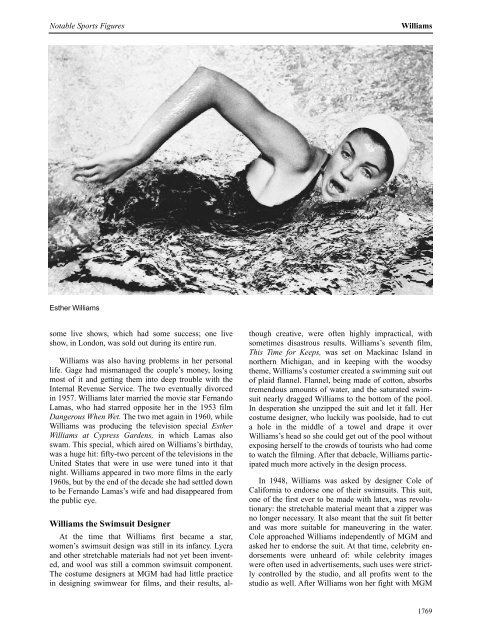Frank Thomas
Frank Thomas
Frank Thomas
Create successful ePaper yourself
Turn your PDF publications into a flip-book with our unique Google optimized e-Paper software.
Notable Sports Figures<br />
Esther Williams<br />
some live shows, which had some success; one live<br />
show, in London, was sold out during its entire run.<br />
Williams was also having problems in her personal<br />
life. Gage had mismanaged the couple’s money, losing<br />
most of it and getting them into deep trouble with the<br />
Internal Revenue Service. The two eventually divorced<br />
in 1957. Williams later married the movie star Fernando<br />
Lamas, who had starred opposite her in the 1953 film<br />
Dangerous When Wet. The two met again in 1960, while<br />
Williams was producing the television special Esther<br />
Williams at Cypress Gardens, in which Lamas also<br />
swam. This special, which aired on Williams’s birthday,<br />
was a huge hit: fifty-two percent of the televisions in the<br />
United States that were in use were tuned into it that<br />
night. Williams appeared in two more films in the early<br />
1960s, but by the end of the decade she had settled down<br />
to be Fernando Lamas’s wife and had disappeared from<br />
the public eye.<br />
Williams the Swimsuit Designer<br />
At the time that Williams first became a star,<br />
women’s swimsuit design was still in its infancy. Lycra<br />
and other stretchable materials had not yet been invented,<br />
and wool was still a common swimsuit component.<br />
The costume designers at MGM had had little practice<br />
in designing swimwear for films, and their results, al-<br />
Williams<br />
though creative, were often highly impractical, with<br />
sometimes disastrous results. Williams’s seventh film,<br />
This Time for Keeps, was set on Mackinac Island in<br />
northern Michigan, and in keeping with the woodsy<br />
theme, Williams’s costumer created a swimming suit out<br />
of plaid flannel. Flannel, being made of cotton, absorbs<br />
tremendous amounts of water, and the saturated swimsuit<br />
nearly dragged Williams to the bottom of the pool.<br />
In desperation she unzipped the suit and let it fall. Her<br />
costume designer, who luckily was poolside, had to cut<br />
a hole in the middle of a towel and drape it over<br />
Williams’s head so she could get out of the pool without<br />
exposing herself to the crowds of tourists who had come<br />
to watch the filming. After that debacle, Williams participated<br />
much more actively in the design process.<br />
In 1948, Williams was asked by designer Cole of<br />
California to endorse one of their swimsuits. This suit,<br />
one of the first ever to be made with latex, was revolutionary:<br />
the stretchable material meant that a zipper was<br />
no longer necessary. It also meant that the suit fit better<br />
and was more suitable for maneuvering in the water.<br />
Cole approached Williams independently of MGM and<br />
asked her to endorse the suit. At that time, celebrity endorsements<br />
were unheard of: while celebrity images<br />
were often used in advertisements, such uses were strictly<br />
controlled by the studio, and all profits went to the<br />
studio as well. After Williams won her fight with MGM<br />
1769

















